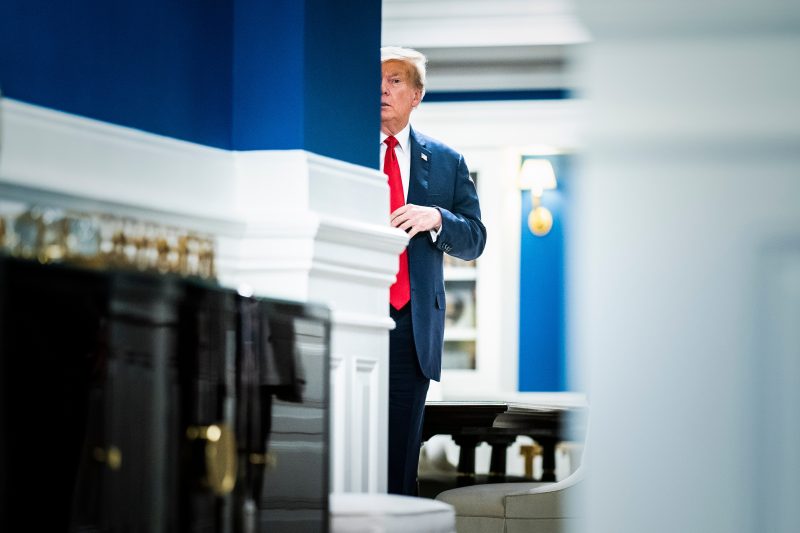There is no question that Donald Trump appears at least indifferent when his supporters engage in violence on his behalf. There are numerous examples and compilations of those examples, to an extent that barely warrants recapitulation.
So let’s just consider two examples that bookended his first tenure as president.
On the campaign trail in 2015 and 2016, he actively encouraged supporters at his rallies to attack protesters. On the day of the 2016 Iowa caucuses, for example, he suggested that protesters might be planning to throw tomatoes at him. So, he said, supporters should feel free to “knock the crap out of ’em” — and that he would pay their legal costs. A few weeks later, one of his supporters attacked a protester. When subsequently asked about his promise, Trump claimed that he had never promised to pay any legal fees.
Then there was Jan. 6, 2021. The riot that unfolded that day was not explicitly directed by Trump; at no point did he say the equivalent of “please attack Congress.” Instead, he endlessly stoked his supporters’ anger, framing his electoral loss as an attack on America itself. He called supporters to Washington, riled them up and pointed them at the Capitol. Then he sat back and watched — with apparent approval — as the finalization of his loss was delayed.
That is the pattern that’s unfolding now, as Trump seeks reelection and tries to derail the various criminal investigations of his actions. In many ways it’s less important that he give tacit approval to violence than that he actively gives his supporters reasons to feel that violence might be necessary.
On Tuesday, Trump appeared in court in Washington as his attorneys argued that he had immunity from prosecution for his actions after the 2020 election. It went poorly, as might be expected. (When your lawyer is arguing that a president could have an opponent assassinated without facing criminal charges, you should assume that your position isn’t that solid.)
After the hearing, Trump spoke to reporters. He began by noting polling that showed him leading President Biden.
“I think they feel this is the way they are going to try and win,” Trump said, referring to the criminal cases. “And that’s not the way it goes. It will be bedlam in the country.”
“It’s a very bad thing,” he continued. “Very bad precedent. As we said, it’s the opening of a Pandora’s box. That’s a very sad thing that’s happened with this whole situation. When they talk about threat to democracy, that’s your real threat to democracy.”
The “bedlam” line generated a lot of headlines, as did Trump’s failure to respond to a question about asking his supporters not to engage in violence, though that question came as Trump was nearly out of the room. The “bedlam” comment is certainly fraught; the events that led to the Capitol riot were triggered by Trump’s December 2020 tweet calling people to Washington on Jan. 6, with the promise that it would “be wild.” But that latter assertion, that the actual threat to democracy (and by extension, the country) is his legal problems? It’s doing the necessary work of elevating the sense of danger that he and his followers face. It’s gathering the wood and pouring the gasoline so that Trump need not be the one to strike the match.
The riot at the Capitol and Trump’s efforts to retain power despite his 2020 loss (an effort that began well before the election itself) spurred new consideration of the frailty of American democracy. Here was a president attempting to subvert the will of voters to stay in office, as explicit a step toward authoritarianism as the country has seen. When pollsters began asking Americans how concerned they were about democracy collapsing, though, a surprising pattern emerged: Democrats and Republicans often expressed similar levels of concern.
A poll conducted by Suffolk University for USA Today last month explored this dynamic in detail. Respondents were asked whether they were worried about threats to democracy; half said they worried about such threats a great deal, with an additional third saying they worried somewhat.
The numbers for Democrats and Republicans were similar.
Suffolk also asked people two questions centered on their acceptance of Trump’s claims about fraud in 2020: whether they were confident the results of this year’s election would be counted correctly and whether they thought Biden’s election was legitimate. Among those who were not confident in this year’s results or in the results from 2020, significantly more respondents said they were concerned “a great deal” about democracy.
Overall, an equivalent number of respondents said they thought Democrats posed the bigger threat as said that Republicans did. Among independents, slightly more pointed at Democrats, though the difference wasn’t significant.
Suffolk also asked why those who were concerned about democracy had that concern. Among Democrats and overall, a plurality of respondents pointed to Trump. Three in 10 respondents overall and two-thirds of Democrats identified Trump, Republicans, MAGA supporters or general concerns about dictatorship. Only 7 percent of Republicans identified those factors.
Instead, a plurality of Republicans pointed to immigration or the border. A quarter of Republicans (and about 1 in 10 respondents overall) identified Biden or Democrats. About 1 in 10 identified election integrity or general concerns about the Constitution. Slightly more pointed to government corruption.
None of these responses (individual responses categorized by Suffolk) gets specifically at Trump’s insistence that his indictments are an erosion of democracy. But he’s already been effective at convincing his base that those indictments are meant to hobble him politically so that he couldn’t fight on their behalf. His comments Tuesday both reframe that argument and muddy the water on what the threat to democracy actually looks like.
This isn’t a new argument from him. Last month, he gave a speech in which he tried to do broadly the same thing, arguing that Biden is the real threat to democracy. In Suffolk’s polling, only 2 percent of Republicans (and no one who thought Biden’s win was illegitimate) said they thought Trump was the threat to democracy. Eight percent said that Biden was.
Trump’s rhetoric here isn’t explicitly demanding his supporters literally fight for him, nor did his prediction of “bedlam.” Both instead allow his supporters to rationalize doing so; after all, democracy is at risk! “Bedlam” is a natural response!
And had he responded to the question about discouraging violence, it probably wouldn’t have mattered. When he was asked during a 2020 presidential debate to tell his supporters not to engage in violence, he said he was happy to do so, telling the Proud Boys — a far-right group with a history of violence — to “stand back and stand by,” instead of telling them, as asked, to stand down.
The Proud Boys were a central part of the violence at the Capitol.



























